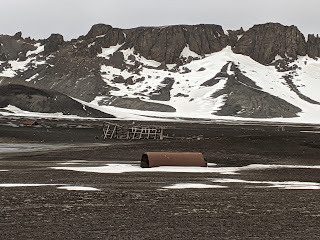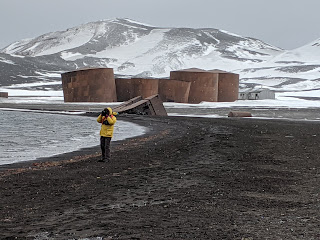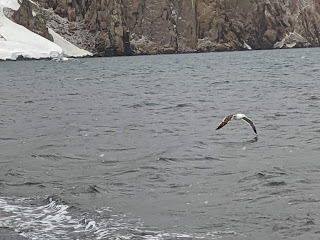We had been told the night before at the Evening Recap to be up and on the deck at 6:30 to watch from the bow as the ship entered the narrow entrance to Deception Island. I watched for a while as the ship entered the notorious Neptune’s Bellows close to the eastern rock walls of the island's collapsed caldera.
It was bitterly cold where we stood hugging the ship, I can't believe how much colder it had to have been for these brave souls encountering the winds head on. I didn't stay out for long because of the piercing cold and numbing winds.
Do you get the sense how ... cold it was on board the zodiac for Carol and Keith from Australia?! Steven had bought something called a buff that could either be worn as a hat or to cover his face to ward off the cold as he hates that above all else. I wish I had done the same.
The base was occupied continuously until December of 1967 when it was evacuated because of a volcanic eruption. It reopened a year later but was closed again in February of 1969 following another eruption. That resulted in a mud flow that destroyed most of the buildings and also dramatically changed the topography and coastline of Whalers Bay and also engulfed the whalers' graveyard.

During the 1990-91 and 1991-2 seasons, clean-up operations were undertaken at the base. All remaining fuel, batteries and hazardous wastes as well as a large amount of general debris were removed. Though further clean-up of the area is planned, the abandoned buildings won't be removed because the mud flow was regarded ass being of international geological importance and also because the building remains were a demonstration of the power of volcanic eruptions. The whaling station was listed as an Historic Site and Monument #71 under the Antarctic Treaty in 1995.
There were two stations here, one each belonging to the British and the Chileans, according to Pablo.
You can tell we walked a good distance around the island as the oil tanks were on the opposite side when I looked back and took this photo.
The zodiac ride took just five minutes to get to the rocky shore where there were lots of Chinstrap penguins which we hadn’t seen since our first trip ashore.
How I wish I had known my Antarctic birds or had asked one of the crew members what this solitary soul was.
As we returned on the zodiacs to the ship, I think everybody was sad that we’d just had our last trip ashore here in Antarctica and, for me, hard saying Adios to the adorable penguins we'd likely never see again.
We’d been lucky that we’d hardly felt any motion on the ship for the last several days unlike when we’d gone through the Drake Passage the first two days out from Ushuaia. It was so easy to get blase about being on the ship after going through the passage and not be as careful certainly as we'd been instructed at the beginning by keeping both hands free all the time when we moved about the ship.
This narrow opening was also shallow in the middle, so the captain had to hug the starboard side.
It was bitterly cold where we stood hugging the ship, I can't believe how much colder it had to have been for these brave souls encountering the winds head on. I didn't stay out for long because of the piercing cold and numbing winds.
Do you get the sense how ... cold it was on board the zodiac for Carol and Keith from Australia?! Steven had bought something called a buff that could either be worn as a hat or to cover his face to ward off the cold as he hates that above all else. I wish I had done the same.
Our landing on Deception Island was at Whalers Bay where we were able to walk between the historical remains from the whaling era as well as the abandoned British Antarctic Survey Station. Whalers Bay had been the location of so many conflicts because it was a political hotspot in Antarctica among Britain, Chile and Argentina that the need for the Antarctica Treaty became necessary, according to Pablo, the Expedition Leader.
The fuel tanks belonged to the British during their battle with Argentina in the Falklands War or as the Argentines call the islands, the Malvinas.
What an adventure to actually enter the ancient volcanic crater of this ring-shaped island that measured over nine miles in diameter.
Whalers Bay at Port Foster on the island had a history of human occupation dating from 1911 when a whaling station was established by the Norwegians. It operated until 1931 until there was a slump in whale oil prices.
In February of 1944, the British Royal Navy established a base on the island using three of the abandoned whaling station buildings. Base B operated for just one year before it was turned over to the forerunner of the British Antarctic Survey and became a scientific research station. It focused on meteorology and and the operation of an air facility to support survey work and the other British bases in the Antarctic Peninsula region.

Luckily, much of the abandoned British research base and the Norwegian whaling station was still there to be seen.
The island was a very harsh place for all who lived there because of the extreme climate, the lack of resources, etc. When the volcano last erupted in the 1970s, almost everything on the island was destroyed including the cemetery. It was recently uncovered so the history of the island could be revealed.
What a godforsaken spot to be buried, so far from one's home and family.
Pablo mentioned that on the day of the eruption, all the animals on the island left as they sensed what was to happen. I remember hearing the same thing happened before the huge tsunami that hit Southeast Asia in 2004.
There were two stations here, one each belonging to the British and the Chileans, according to Pablo.
This was also one of the biggest whaling stations anywhere in the Antarctic. The whalers used the boilers to cook the whale blubber, mixed with hot water, to produce nitroglycerin, marrow and paraffin. That was later used for pet food and also in the production of makeup among other products. The whale bones were used for fertilizer.
The gap between the cliffs was Neptune’s Window, our destination in a bit!
These were the only penguins we caught sight of on Deception Island. I knew we had our last landing of the ten-day trip that afternoon and was sure hoping I would get in another penguin fix!
During the summer months, over 1,000 people lived and worked here.
As we walked along the east side of the bay, there were various relics of the whaling station, including water boats, timber barrels and large quantities of whalebone.
One of the larger pieces of whale bone we saw that had been bleached white with the passage of almost a century since the last whaling operations took place at the bay.
Gray skies, gray ash-covered beach and even the sea appeared to be gray that day!
The remains of a freshwater boat that was so critical to existence on the island:
Another piece of whale bone:
We trudged up the hill toward the gap known as Neptune's Window.
What a sense of accomplishment as we reached the top and took in the exhilarating sights of the water and the cliffs from the narrow ledge. Because it was so narrow, we couldn't stay long and had to leave so another group from the ship could also take in the great views.
If you look closely, you can just spot the Ushuaia in the distance and get a sense of the considerable expanse of water we traversed in the zodiacs to reach the shore of Whalers Bay.
In the distance in Neptune's Window were two more groups of passengers from their zodiacs.
Walking back along the beach, I lucked out capturing a bird just land in the water by another one.
When Pablo had announced the night before that 'crazy' passengers could go on the Polar Plunge today which meant basically jumping in and out of the 32 degree water, I thought that perhaps a dozen of the younger ones might take him up on the crazy idea. Never did I think that very close to half of the 90 passengers on board might actually do it! About 20 or so people went in initially and then the lure of being in the Antarctic waters seemed to catch fire and the others followed suit.
Fortunately, the crew had been well prepared and brought lots of towels along to wrap the swimmers in as soon as they ran out of the water. None I heard complained about the cold water, thinking it was going to be even colder than it was. What a story they had to tell family and friends back home.
This skinny dipper was one of the 20 or so US students from many universities who were doing a semester abroad in the city of Ushuaia!
Two of these guys were the brothers who had served together in the Army and had been based in Afghanistan as had their father. If you read the previous post, you may recall a photo I took of them raising their unit's flag atop a hill.
Around 4, we had our last landing of the trip at Half Moon Bay, named simply because of its shape. We waited our turn and watched from the ship as other passengers left before us for the quick trip to the landing site.
Yeah, our turn at last to board the zodiac of the stern!
I bet you also had identified this as a Chinstrap penguin, right?!
I loved following the progress of some of the penguins making their way up the 'penguin highway' from the shore to the rocky outcrop!
Steven had paused to allow the penguins to pass in front of him as we knew to allow a minimum of five meters between us and them.
Their 'highway' was pinkish because of the color of their poo as you might have guessed!
Liesbet: Thanks for your suggestion from the previous post on how to load some of the videos I took of the cute penguins into the blog so many more people can also be amused by their antics. I don't have the time to follow your ideas but will get to it asap. Possibly, will just have one post devoted to short videos of the penguins.
Steven and I remarked how we’d never thought that Antarctica had mountain ranges before coming here, so have been struck by the beauty of the mountains we’ve viewed. Perhaps other passengers had done some reading of what to expect in advance of this mind-blowing trip, but clearly we hadn't so it was all a wonderful surprise and revelation!
I was so going to miss these little cuties as they had found a way into my heart.
That lone black spot was a penguin, trudging along step by step on the thin layer of crusty ice covering the snow.
Our goal or destination was the small building in the distance on the right that was a Chilean research station.
How I wish I had known my Antarctic birds or had asked one of the crew members what this solitary soul was.
The mountains weren't the Rockies or the ones we'd soon see in Torres del Paine National Park in the Chilean section of Patagonia but they were majestic, nonetheless.
I loved how for the first time all trip we were able to escape from the madding crowd a bit and just go off on our own here on Half Moon Island.
What an absolute delight being the first people to walk in the snow in this part of Antarctica that day. We had specifically chosen this time of the year to travel to the continent knowing it was the beginning of the travel season and therefore the snow would be much whiter.
My attempt at a somewhat graceful recovery from falling through the snow!
We weren’t sure for quite a while whether it was a rock in the distance or a seal until we finally saw some very slow and seemingly tentative movement! I found out later it was a Weddell seal. I felt ignorant that, prior to this trip, I hadn’t known there were so many different types of seals.
We finally reached Camara, the Argentine Summer Research Station but it had yet to open for the summer season. Pablo said he doubted it would open because his country’s president wasn’t a fan of the sciences and also because of the country’s poor economy. However, one of the other crew members who happened to be a scientist said it had opened last summer and would definitely open again soon. She added that the scientists would be working on many different topics.
We noticed a few crosses on the hill immediately behind the station and asked the crew about them. We were told that they were likely either graves from people who had perished here prior to the Antarctica Treaty or simply honored people who had once lived here because the treaty forbade burials now in Antarctica.
As we returned on the zodiacs to the ship, I think everybody was sad that we’d just had our last trip ashore here in Antarctica and, for me, hard saying Adios to the adorable penguins we'd likely never see again.
That night we started preparing our return 'home' to the ship's port of Ushuaia so it was time to secure our belongings and prepare for the Drake Passage again!
Next post: The slow trip back to port.
Posted on December 16th, 2019, from Buenos Aires, Argentina, on our last night on the road of this amazing six-week log trip to Antarctica, Patagonia and Paraguay.






















































































































ABSOLUTELY AMAZING ADVENTURE to Deception Island Antarctica !!! Next time.. polar plunge for your both ! xo
ReplyDeleteLina,
DeleteThe trip to Antarctica, Patagonia and Paraguay that we just returned from yesterday was one of the top trips we've ever taken without a doubt. We already talked about the very slight possibility of returning another time and going to another area of Antarctica. If so, you are so right, I will definitely do the polar plunge as I regret my vanity got the better of the opportunity of swimming in the Antarctic.
XOXO right back at you!
What an adventure! Good idea to go early in the season (although it must have been colder as well) to walk on pristine snow. Dealing with so many other people on these excursions would be tough for us... Maybe there are cruises that take less passengers, but I can’t imagine how much more expensive that would be!
ReplyDeleteI remember skinny dipping in the Arctic Ocean in 2004. It was numbingly cold, but the tour guide had towels ready and the heater in the van at full blast! :-) I’d have to repeat this insanity if I were ever to get a chance in the Antarctic Ocean!
Liesbet,
ReplyDeleteI think our decision to go first thing in the season was sound but it did leave me wondering how different a trip might be later in the season in terms of animal life, topography, the calmness or not of the seas, etc. One of the major reasons we chose the ship the Ushuaia was there were for us only 90 passengers compared to the much larger ships. The only time we really noticed all the people was at mealtimes as we went ashore in the zodiacs in small groups, and often stayed together in those groups when ashore as we did at Deception Island. For a very basic, no frills cruise, you can't beat the Ushuaia, a former scientific research vessel, that was managed by Antarpply. I would recommend it in a heartbeat.
I wish I had made the decision on the spur of the moment to take advantage of the Polar Plunge as I regret it now. Stupid me - it was a question of vanity as I didn't bring my swimsuit along and didn't want to go in my skivvies!
I understand that. You could have gone naked as well. :-)
ReplyDelete